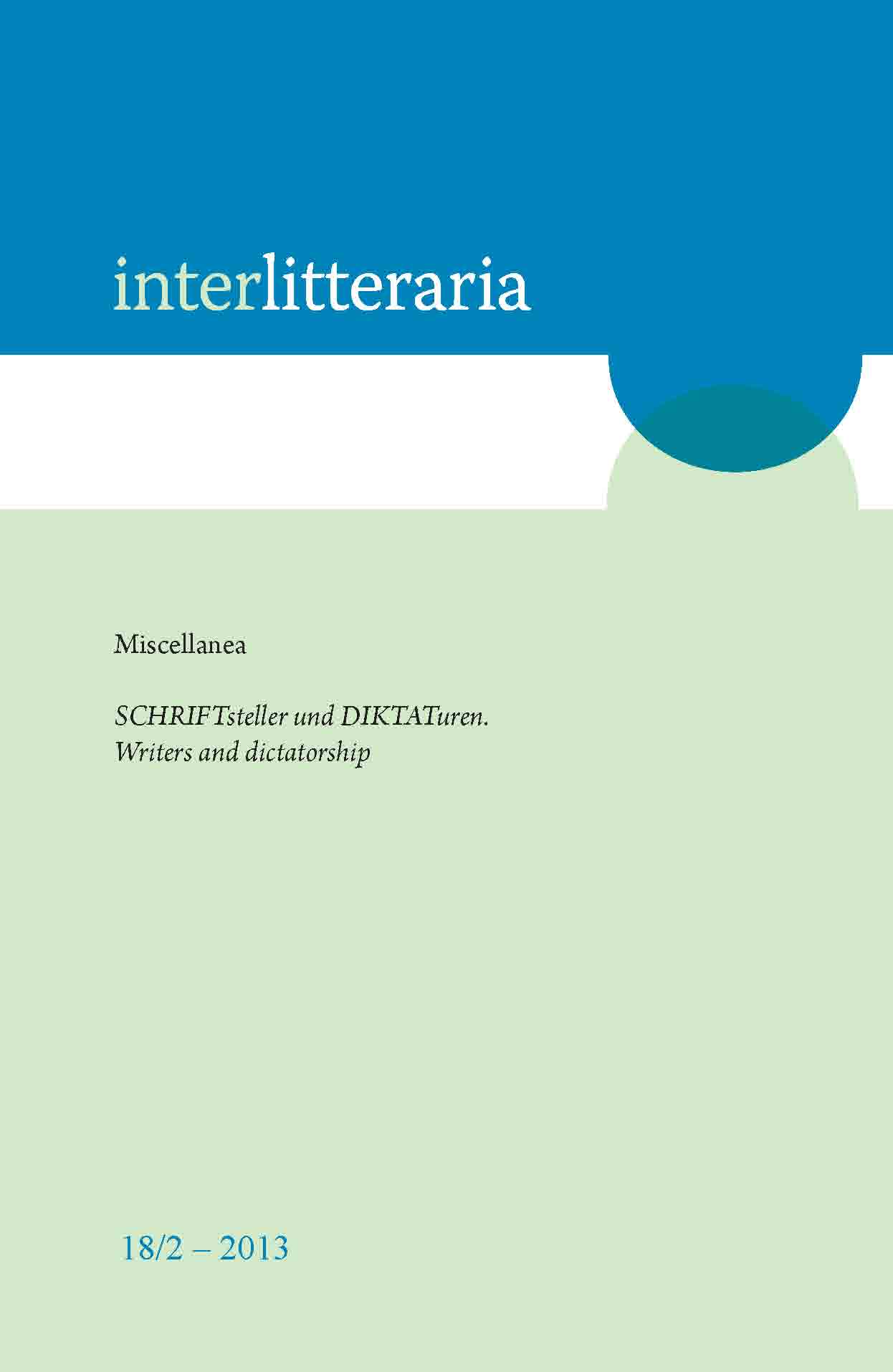Sonnet as Closed Form and Open Process
DOI:
https://doi.org/10.12697/IL.2013.18.2.03Keywords:
sonnet, poetry genres, semiotics of poetry, comparative poeticsAbstract
The article attempts to highlight two aspects of the sonnet’s semiotic mechanisms from which the dynamics and openness of this form emerge. Firstly, in the production of meaning from the synchronic aspect and secondly, diachronically viewing the sonnet as a process that has a tendency towards the constant opening of this canonical form. So the boundaries of the sonnet are not only closing the form but also lead every single sonnet towards opening. The paper aims to indicate through the history of the sonnet and some exemplary cases the essential characteristics of this canonical form of poetry, suggesting that inner openness and flexibility is in the very core of the sonnet. It is suggested that experimenting with the form is very essential to the sonnet; stretching the limits of the sonnet helps to mark its boundaries and at the same time these dynamics stand for its longevity. This is the reason why the sonnet has remained a challenge over centuries in so many cultures.Downloads
Download data is not yet available.
References
<div class="WordSection1"><p>Bermann, S. L. 1988. <em>The Sonnet Over Time. A Study in the Sonnets of Petrarch, Shakespeare, and Baudelaire</em>. Chapel Hill and London: The University of North Carolina Press.</p><p>Bregman, D. 2005. <em>The</em><em> </em><em>Golden</em><em> Way. </em><em>The</em><em> </em><em>Hebrew</em><em> </em><em>Sonnet</em><em> </em><em>during</em><em> </em><em>the</em><em> </em><em>Renaissance</em><em> </em><em>and</em><em> </em><em>the</em><em> </em><em>Baroque</em>. Tempe, Arizona: Arizona Center for Medieval and Renaissance Studies.</p><p>Burckhardt, J. 1958. <em>The Civilization of the Renaissance in Italy</em>. New York: Harper & Row.</p><p>Burt, S., Mikics, D. 2010. <em>The Art of the Sonnet</em>. Cambridge, Massachusetts, London, England: The Belknap Press of Harvard University Press.</p><p>Burt, S. 2012. The contemporary sonnet. – A. D. Cousins, P. Howarth, eds. <em>The Cambridge Companion to the Sonnet</em>. Cambridge: Cambridge University Press, 245–266.</p><p>Muldoon, P., Tyler, M., Hilson, P. 2012. Contemporary poets on sonnet: a trialogue. – A. D. Cousins, P. Howarth, eds. Cambridge: <em>The</em><em> </em><em>Cambridge</em><em> </em><em>Companion</em><em> </em><em>to</em><em> </em><em>the</em><em> </em><em>Sonnet</em>. Cambridge University Press, 6–24.</p><p>Edmondson, P., Wells, S. 2004. <em>Shakespeare’s</em><em> </em><em>Sonnets</em>. Oxford: Oxford University Press.</p><p><em>Every</em><em> Sonnet </em>= everysonnet.blogspot.com (08.04.13).</p></div><p>Fuller, J. 1972. <em>The Sonnet</em>. London: Meuthen & Co Ltd.</p><p>Fussell, P. 1965. <em>Poetic Meter and Poetic Form</em>. New York: Random House.</p><p>Kangro, B. 1938. <em>Eesti soneti ajalugu</em>. Tartu: Akadeemilise Kirjandusühingu toimetised.</p><p>Kirszner, L. G., Mandell, S. R. 2006. <em>Portable</em><em> </em><em>Literature:</em><em> </em><em>Reading,</em><em> </em><em>Reacting,</em><em> </em><em>Writing</em>. Boston: Wadsworth Thompson.</p><p>Lotman, M. 1993 = Лотман, М. 1993. Иннокентий Анненский – разрушитель сонета. – L. Pszczolowska, D. Urbanska, eds., <em>Slowianska metryka porownawcza. V Sonet</em>. Warszawa: Institut Badań Literackich Polskiej Akademii Nauk, 123–131.</p><p>Lotman, M. 2012. Verse as a semiotic system. – M. Lotman, M.-K. Lotman, eds., <em>Sign System Studies</em>, vol. 40 (1/2), special issue: Semiotics of Verse. Tartu: University of Tartu Press, 18–51. <a href="http://dx.doi.org/10.12697/SSS.2012.1-2.02" target="_blank">http://dx.doi.org/10.12697/SSS.2012.1-2.02</a></p><p>Lotman, M.-K., Lotman, M., Lotman, R. 2009. Autometakirjeldus eesti luules II. – <em>Acta</em><em> Semiotica Estica</em>. Tartu: Tartu Ülikooli Kirjastus, 42–67.</p><p>Oppenheimer, P. 1989. <em>The</em><em> </em><em>Birth</em><em> </em><em>of the Modern Mind. Self, Consciousness, and the Invention of the Sonnet. </em>New York, Oxford: Oxford University Press, 13–25.</p><p>Richaud, L. 1867. <em>Histoire</em><em> </em><em>du</em><em> </em><em>sonnet,</em><em> </em><em>sa</em><em> </em><em>grandeur</em><em> </em><em>et</em><em> </em><em>sa</em><em> </em><em>décadence:</em><em> </em><em>entretien</em><em> </em><em>littéraire</em>. Cahors: Plantade.</p><p>Riffaterre, M. 1984. <em>Semiotics of Poetry</em>. Bloomington: Indiana University Press. Scott, C. 1976. The Limits of the Sonnet: Towards a Proper Contemporary Approach. – <em>Revue</em><em> de littérature comparée, </em>50, 237–250.</p><p>Spiller, M. R. G. 1992. <em>The</em><em> </em><em>Development</em><em> </em><em>of the Sonnet. An Introduction</em>. London and New York: Routledge.</p><p>Spiller, M. R. G. 1997. <em>The</em><em> </em><em>Sonnet</em><em> </em><em>Sequence.</em><em> </em><em>A Study of Its Strategies</em>. New York: Twayne Publishers.</p><p><em>T</em><em>i</em><em>r</em><em>n</em><em>a</em><em>nO</em><em>g</em>=TirnanOg–LandoftheEverliving, <a href="http://tirnanogthelandoftheeverliving.yuku.com/topic/22634/Sonnet-Variations-Quick-Reference#.UWF2fKKouSp">http://tirnanogthelandoftheeverliving.yuku.com/topic/22634/Sonnet-Variations-Quick-Reference#.UWF2fKKouSp</a> (08.04.13).</p><p>Yates, W. E. 1981. <em>Tradition</em><em> </em><em>in</em><em> </em><em>the</em><em> </em><em>German</em><em> </em><em>Sonnet</em>. Bern, Frankfurt am Main, Las Vegas: Peter Lang.</p><p>Wagner, J. A. 1996. <em>A Moment’s Monument. Revisionary Poetics and the Nineteenth-Century English Sonnet</em>. Madison, Teaneck: Fairleigh University Press, London: Associated University Presses.</p>
Downloads
Published
2013-12-20
Issue
Section
Articles
License
The contents of Interlitteraria are published under CC BY-NC-ND licence.


